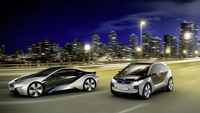World's First Look: BMW iBrand i3 and i8 Concepts - VIDEO ENHANCED
By Henny Hemmes
Senior European Editor
The Auto Channel
FRANKFURT, July 29, 2011. Today I was in Frankfurt where BMW presented the iBrand concept models of its first electric and first plug-in hybrid vehicles. The new sub brand for sustainable mobility of the Bavarian car manufacturer will introduce the production models of the compact electric i3 and the plug-in hybrid sports car i8 on markets world wide in 2013. The development of the i3 started in 2007 under what was internally called Project-i. The first car that was part of the development process was the electric Mini E. It was presented at the LA Auto Show in November 2008 and in 2010 a fleet of test cars hit several big cities worldwide in 2010.
 |
Watch the BMW iConcept animated demo
How the iBrand works)
The i3 Concept has an electric engine on the rear axle. It delivers 125 kw/170 hp and 184 lb.ft of torque, which is available from the standing start. Acceleration takes 7.9 seconds for the sprint from 0-62 mph and 3.9 s for 0-37 mph. The acceleration which is important for overtaking (50-75 mph) takes 6 s. The top speed is (legally) limited at 93 mph.
Fully charging the lithium ion battery pack takes 6 hours through a
house hold socket and fast charging for an 80 percent load costs only one
hour.
 |
• SEE ALSO: The complete press conference video with text report
The electric vehicle has a wheelbase of 101.2 inches, while length, height and width are 151,6, 60,6 and 79.1 inches respectively. The car’s curb weight is 2.755 lbs.
 |
It is combined with a BMW’s own newly developed 1.5-liter 3-cylinder petrol engine with turbocharger, good for 164 kW/220 hp and 221 lb.ft of torque on the rear axle. The combination generates a total power of 260 hp and 406 lb.ft of maximum torque.It provides sports car performance, but with the fuel consumption of a small car. With both system working simultaneously, the i8 has in fact four-wheel drive. The Concept has a top speed of 115 mph, sprints from zero to 62 mph in 4.6 seconds and accelerates from 50-75 mp in 4.6 s. Fuel consumption is approx. 94 mpg in the European cycle (2.7 l/100 km) with a CO2 emission of 66 g/km. Thanks to the lithium-ion battery, that can be fully charged in two hours via a house hold socket, the sports car can drive in electric mode only for some 22 miles.
BMW uses mainly plastic that is reinforced with carbon fiber (CFRP). The material is very light, adding to a lower energy consumption and thus extending the range.
It is also used for the LifeDrive architecture of both cars. In the i8 that has been modified to accomplish a sporty character. The electric engine up front is connected by a so-called ‘energy tunnel’ with the combustion engine in the rear, also providing an ideal 50/50 weight distribution.
The interior is light and roomy, also thanks to the Life module and is executed with raw materials that are visible in the instrument panel and the door panels. The overall feeling is that of a modern environfriendly car indeed.
Stay tuned at The Auto Channel for the back ground information that will be provided during several workshops later this day.
BMW iBrand Preview
BMW Introduces New Sub-Brand Monday Feb 21, 2011
Complete BMW i Series Introduction Press Conference
Live From Munich (February 21, 2011, 45 Minutes)



